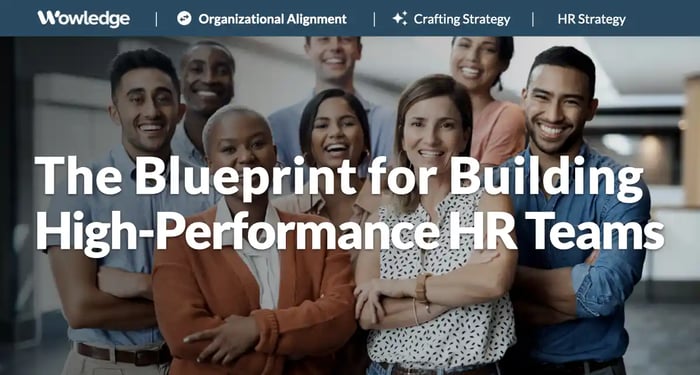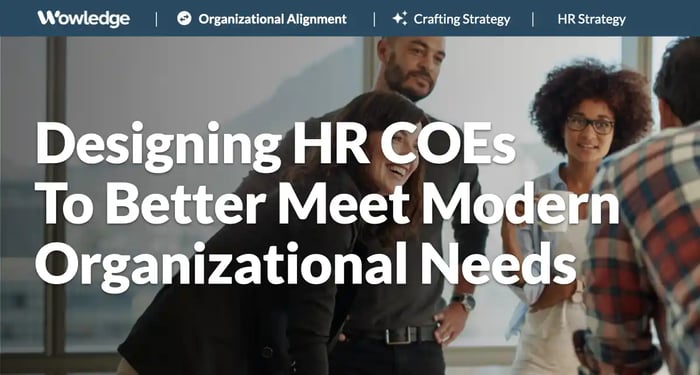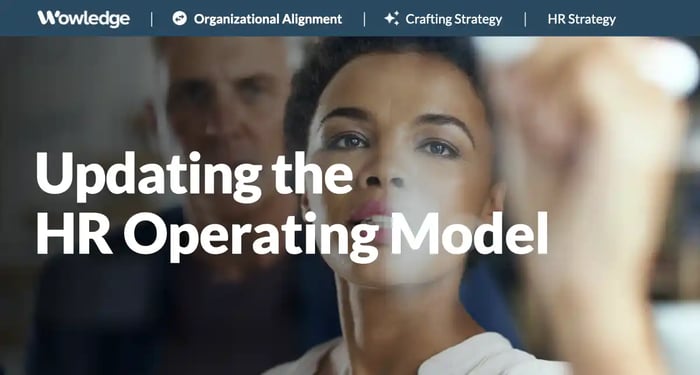Table of Contents
- Challenges and barriers to creating high-performing HR teams
- What defines a high-performance HR team
- The differentiating elements required to establish a high-performing HR team
- Building a high-performance HR team
- Skill and career development priorities
- High-performance HR team deployment action priorities
- Relevant Practices & Tools
- About Wowledge
Much attention is being paid to the need for HR functions to respond to shrinking talent pools, changing government policies and regulations, low employee (and manager) engagement levels, and the rapid advancement of AI technology adoption. Additional focus is being placed on evolving the associated capabilities of HR functions, including analytics, AI, and technology, as well as skills-based talent management and organizational (re)design. What remains is the never-ending quest to establish the foundations of adaptation, business alignment, and superior impact, building high-performance HR teams.
While research provides substantial support for the impact of HR on strategic business objectives and goals, the foundations begin and end with an understanding of how those are accomplished. They are all about the people in HR, and how they are organized, selected, deployed, and managed. The key is to understand what makes a great HR team and how to manage and overcome the many challenges that leaders face.
Challenges and barriers to creating high-performing HR teams
The story that industry research tells can appear daunting, as only 4% of HR teams feel that they deliver an exemplary employee experience. Mercer has found that amongst even the high-performance HR teams, only 66% successfully align their strategies with the business (vs. 16% of lower performers). The lower performers are almost ten times (9.5X) less likely to have their HRBPs viewed as “true strategic partners.”
The HR operating model is identified as a significant contributor, with poor coordination and integration of efforts between HR Business Partners, Centers of Excellence, and HR Shared Services. Interestingly, Mercer reports that only 47% of surveyed U.S. firms with 500+ employees have all three in place, which it found to be a common element of high-performance HR teams. Understaffing and outdated HR team development standards add to the issues they face.
Under-leveraged HR analytics and technology are similarly causing challenges, with less than 15% of mid-sized to large employers having mobile apps that provide personalized, easily used, and readily accessible insights and support to employees and managers. Sixty percent (60%) have no plans or intention to implement chatbots to handle typical and repetitive inquiries, and 50% are not seeking meaningful efficiencies through the adoption of AI and machine learning. Similarly, lower-performing HR teams lag behind in HR or people analytics, with only 23% having both an analytics COE and an aligned HRSS analytics team for execution and delivery. 50% of high-performance HR teams are reported to invest more in analytics than their counterparts (18% of lower performers).
What defines a high-performance HR team
A high-performance HR team is characterized by its ability to drive organizational success through strategic business alignment and the implementation of high-impact policies, practices, processes, programs, and technology platforms. These teams are differentiated based on their contributions to business and operational success, a reputation for excellence in design and execution, and a focus on creating a robust talent ecosystem that supports a culture of customer, financial, operational, and market growth.
Key characteristics of a high-performance HR team include:
- Strategic alignment. High-performance HR teams are closely aligned with the overall business strategy, ensuring that HR processes, practices, and initiatives directly support organizational goals. Their internal processes drive this mapping of goals and work efforts throughout the HR team, from top to bottom. They create a focus on achieving business objectives and continually seek to engage employees in that mission.
- Data-driven decision making. Top HR teams leverage data and analytics to inform strategies, track performance, and make informed decisions. Real-time data is reviewed and used to support leaders’ understanding of trends, occurrences, and circumstances, and is the basis for all consultative conversations and response designs.
- Employee experience focus. They prioritize a positive, engaging, and easily navigable employee experience for all employees, regardless of their level or role. An emphasis is placed on delivering the required support and expertise seamlessly, with complete and accurate responses, minimal handoffs, integrated solutions, and the timely and efficient processing and delivery of both administrative and tailored solutions.
- Continuous improvement, adaptability, and agility. These teams foster a culture of continuous improvement in their processes, practices, programs, and approaches. They rely on evidence-based HR (EBHR) and process improvement methodologies to review, update, and refine their service, support, and consultation delivery models. They demonstrate an ability to pivot and adapt their approaches and strategies in response to market and operational shifts, as well as with advancements in methodologies and technologies.
- Focus on culture, communication, and collaboration. High-performance HR teams foster open communication, trust, and cooperation both within the HR team and across other departments. They treat culture as a driver of business mission and objectives, monitoring its health and the extent to which leadership and management decisions, communications, and behaviors align with and are consistent with it. They develop programs and processes that encourage employee input and collaboration, aiming to engage them in the process of organizational growth and prosperity.

The differentiating elements required to establish a high-performing HR team
Advancing an HR team to high performance requires a solid and comprehensive ecosystem that supports and enables team members to work together effectively across job functions, share priorities and focus, and deliver superior outputs to their shared (internal) customers. The ecosystem encompasses the organization's structure, its priorities, the team’s shared values and expectations, and the collective capabilities of its members. Regardless of the size and scale of the HR team, from small local groups of generalists to larger, more dispersed, and specialized sub-teams, high-performance HR teams share many of the same characteristics.
Organization structure and operating model
A business-aligned structure is key, as is a well-articulated operating model that clearly defines individual (and sub-team) roles, responsibilities, and relationships. One of the biggest challenges for HR teams is effectively managing internal customer relationships. As a result, top teams utilize process mapping and responsibility assignment tools (e.g., RACI matrix) to guide who “owns” the relationship with line leaders or managers, how each type of HR support is delivered and by whom, and how they collaborate.
One prime example is the strategic support assigned to HRBPs and the administrative or employee relations support requests that they receive. High-performance HR teams have agreed-upon processes and responsibilities, with HRSS handling policy and transactional requests from managers and employees. As a result, HRBPs have the time to coordinate strategic responses with COE experts. Similarly, KPIs, OKRs, and talent analytics are often defined by HRBPS and COE experts, and then executed and presented in reports or dashboards by members of the HRSS team.
Operational focus and priorities
High-performing HR teams are differentiated by their mission and the prioritized areas of service and support they focus on. Regardless of team size or scale, they understand that their purpose and value proposition extend well beyond the required administrative and processing components of their role. Even with limited resources, they identify what they can afford to focus on that helps drive the business. Regardless of the circumstances, top teams find ways to deliver value beyond payroll, benefits, and onboarding.
- Contribute to driving business outcomes. Align (and communicate) all HR strategies, objectives, processes, and practices with specific business purposes and outcomes. Prioritize efforts that drive operational improvements in terms of costs, efficiency, effectiveness, and customer value.
- Build and manage culture and the employee experience. Monitor the “pulse” of the people – employees, managers, and leaders—and work to maintain alignment between leadership and managerial plans, behaviors, decisions, and actions that align with agreed-upon cultural expectations and aspirations. Ensure that HR policies, practices, processes, and initiatives support those. Utilize employee listening strategies to evaluate work environments, pinpoint problem areas, and develop rapid response capabilities to mitigate any potential issues.
- Embrace continuous improvement and innovation. Demonstrate HR’s commitment to business alignment by redesigning inefficient processes, calming complaints about cumbersome actions, and administrative tasks. Lead the organization by focusing on common-use HR processes, and use that expertise to help the business identify its opportunities to improve its workflows. Use a data-centric approach to identifying trends, supporting decisions, and designing new, innovative solutions with EBHR.
Team values
High-performing HR teams possess shared values that serve as a lens through which they view the organization and their approaches to performing their work. They are committed to these values and accept being held accountable for them, holding themselves and each other responsible for adhering to them.
- Business savvy. Teams place a high value on understanding what drives the company, its customers, and the (internal and external) supply chain. They are motivated to align with it and identify issues and opportunities for improvement for its benefit. These individuals seek opportunities to participate in business planning, strategy development, and managing customer and supply chain partner relationships.
- Customer-centric. These teams understand and focus intently on meeting the needs of their “internal customers” or business partners. They are committed to partnering for improvement through coaching, facilitating cross-functional collaboration, problem definition and resolution, and continuous “pulsing” and consultation.
- Analytically capable. They have an understanding and appreciation for generating an objective knowledge of trends, occurrences, and operational issues. While not every team member is a statistician or data scientist, they are, at the very least, capable of reviewing, understanding, and interpreting data, analyses, and reports. As a team, they have more advanced capabilities that enable them to ask questions and guide analytic experts in generating integrated business, operational, and HR analyses that shed light on situations facing their line managers.
- Externally aware and informed. High-performance HR teams have an active interest in research, best practices, and benchmarks that reveal leading and emerging trends. They seek insights into labor markets, new concepts and practices that offer potential solutions to old problems, and benchmarks or insights that can spark continuous improvement and innovative ideas.
- Challenged by aggressive goals. These teams are noted for taking on stretch goals that represent significant potential wins, but are well-founded, researched, informed, and carefully planned. The leaders encourage taking calculated gambles while establishing (and following through with) standards for protecting team members from adverse consequences of failure.
Team member characteristics
Top HR teams need people who are not only committed to the group’s mission and values but also possess the talent and motivation to apply those values in their work consistently. Recognizing that not everyone possesses the aptitude, interest, skills, or experience in every area, it is essential to focus on team members who have strengths in multiple aptitudes or abilities, and then build the team around a portfolio of capabilities that cover all the required bases.
Functional expertise in role-required areas is the primary requirement for any team member, encompassing an appropriate combination of depth of expertise and breadth of experience relative to the job requirements and level. Beyond that, and for each of these, teams strive to have members who possess the proven aptitude, drive, and a demonstrated history of consistently acting in this manner. Examples of critical characteristics around which a high-performance HGR team can be built include:
- Business savvy and interest
- Customer focus
- Relationship, trust, and influence building
- Strategic and integrative thinking
- Creativity, resourcefulness, and problem-solving
- Curiosity, open-mindedness, critical thinking, and continuous learning
- Flexibility, agility, adaptability
- Technologically savvy
- Analytically inclined and reliant
- Consultative
Additional capabilities and characteristics to look for include:
- Functional breadth—the ability to understand and collaborate across HR specialties
- Change management
- Project management
- Statistics and advanced analytics
- Process design and optimization
Does this seem too much to ask for? Perhaps, but consider the most consistent of championship-winning sports teams. While they do not win the trophy every year, they adhere to the core of their winning formula: fostering a great culture, hiring individuals with values and personal traits aligned with the team’s philosophies, standards, and direction, and continually training and developing their team members. Given that their top performers often leave (winning teams are always targets for competitor raiding), they create contingency staffing plans and hire and develop skilled, culturally matched future leaders as replacements to ensure continuity and sustainability.

Building a high-performance HR team
Building and maintaining a high-performance HR team requires a structured and disciplined process that not only establishes and manages to high standards, but also integrates HR functional capabilities for its internal benefit.
- Strategic hiring: Recruit individuals with diverse skills and a strong understanding of both HR principles and business needs. Use multi-faceted methods to generate more robust and comprehensive candidate evaluations, including job sample tests and formal, validated assessments (e.g., aptitude, EI) to strengthen confidence in selection decisions. Hire a mix of entry-level and experienced professionals, as well as others with operational (non-HR) experience that can add business expertise to the team.
- Professional development: Invest in training and development opportunities to enhance HR and business skills and knowledge. Focus on well-rounded learning opportunities that are personalized and attuned to individual role requirements, career arc, and aspirations. Consider Mercer’s finding that high-performance HR teams are 3.5X more likely to invest in HR skill development. It reported that these investments are disproportionately focused on developing persuasive communication skills, negotiation techniques, and basic analytics, as well as insight generation and accurate interpretation.
- Clear goals and expectations: Set clear goals and expectations for the HR team and individual team members, particularly focused on guiding them towards collaborating and integrating efforts. Consider team-based cascading goal setting, where teams share ideas about how they, both individually and collectively, can define and set more aligned and ambitious performance goals. Share, communicate, and recognize the demonstration of team values.
- Performance management: Implement effective performance management systems to track progress and provide feedback, including testing and role modeling of improved processes and techniques that the team can bring to their internal “customers”. Seek and create opportunities for measurable goals, KPIs, or OKRs through surveying, HR practice-to-business-impact metrics, and analytic assessments.
- Open communication and feedback: Outside of the performance evaluation process, foster open communication amongst the team with regular team feedback and discussion sessions. Use these to target differentiating sources of high performance, such as post-mortem reviews of projects and initiatives, as well as reviews of HR process effectiveness and efficiency. Use these sessions to facilitate honest, yet constructive opinions and assessments of what is, or is not, working well in terms of cross-team collaboration (e.g., HRBP, COE, HRSS), customer interface, and steps for future improvement.
- Cross-functional awareness: Build an appreciation of the role and elements of other HR functions and opportunities to increase or better collaborate and integrate their efforts. High-performance HR teams consider these in terms of how they can better deliver support and services to line organizations, managers, and employees. Utilize integrated project teams to identify and develop more robust solutions to organizational issues and problems, enhance processes, and cross-train HR team members.
- Recognition and rewards: Acknowledge and reward high-performing individuals and teams for their contributions and innovations, demonstrating shared values, and helping drive improved business outcomes. Create opportunities for peer and customer kudos, as well as those for HR teams to express gratitude for cross-functional support received from internal and external partner functions and organizations.
- Bring meaning to their work: Help each HR employee understand how their work is related to the company, function, business unit, or customer goals, objectives, and initiatives. Provide this context to individuals and teams so they have an ongoing sense of their importance, how they fit into the company value chain, and how increasing their effort, results, and drive can enhance that even further.
Skill and career development priorities
Identifying the opportunities for a continuous learning and development environment for high-performance HR teams is an essential step towards supporting their growth and the expansion of the team’s capabilities. A deliberate and structured approach is recommended to optimize the entire HR organization’s ability to deliver consistently against its (and the business’s) objectives. Informal learning, particularly activities integrated into the daily workflow, provides some of the most cost-effective and robust skill development experiences.
- Coaching based upon formal methods and standards that develop skills while role modeling how HR professionals should interact with their clients.
- Training on active listening, collaboration, and influencing behaviors. Utilize staff meetings and team interactions as opportunities for team coaching, feedback, and learning.
- Consulting based on a formal model, such as performance consulting or organization development (OD) methodologies.
- Access to external expertise, including conferences, seminars, and boot camps, that provides exposure to new experts, perspectives, thinking, trends, and methods. This includes access to academic journals, professional research and publications, webinars, and podcasts.
- Engaging with line organizations directly and conspicuously to learn their strategies and priorities, as well as how their work is conducted, performed, and completed (successfully and unsuccessfully). This supports learning the work processes firsthand, how their operations align efforts, and the operational challenges associated with each role performing the work.
High-performance HR team deployment action priorities
Moving beyond individual development, how team members are deployed or assigned goals, work, and roles offers a combination of growth through experience and the development of broader and deeper team capabilities. These actions can also provide the advantage of deepening strategic planning and alignment, as well as career development.
- Use OKRs, KPIs, and agile goal-setting to bring business purpose, meaning, and impact into HR efforts, initiatives, and goals. Cascade team and individual goal development to further ensure alignment, and practice agile goal setting to adapt and adjust as the performance period progresses.
- Engage the team in strategy and goal-setting sessions to get bottom-up perspectives, expose everyone to strategic thinking and business planning considerations, and generate understanding and buy-in for HR goals.
- Co-design, review, and update metrics that HR uses to understand and communicate talent trends, occurrences, situations, and circumstances. Engage team members in reviewing and interpreting KPIs, reports, and dashboards. Encourage discussions about organizational issues and design, and tailor analyses and reports.
- Review HR work processes and associated metrics on a regular schedule to encourage a continuous improvement mentality. Engage employee feedback. Use RACIs to clarify and refine roles & responsibilities related to annual processes and collaborative efforts.
- Use formal project management techniques and methods to plan and execute new HR initiatives.
- Cross-train and rotate job assignments, roles, and special projects to build capability, broaden career opportunities, identify high potentials, avoid burnout, and learn the unique skills developed in COE, HRSS, and HRBP-related assignments.
Relevant Practices & Tools
Advanced HR Strategy Practices to Plan for Delivery of Impactful HR Services and Support. >
Advanced HR Strategy is a refined approach to planning long-term HR priorities. It involves increased specificity of plans and goals around key employee groupings and uses detailed workforce data and projections to clarify the needs and trends impacting those groups... more »
Evaluating and Selecting an HR Service Delivery Model that Optimizes Short and Longer-term Impact. >
Before determining how to structure an HR team, a set of considerations should be reviewed regarding the "operating or service delivery model" to be implemented... more »
Conducting Performance Consulting-based Learning Needs Assessments for Specialized Solutions. >
“Performance Consulting” addresses workplace performance issues through a structured approach to understanding and resolving them... more »
Deciding on the Framework, Elements, and Model for Effective Coaching and Mentoring Application Consistency. >
There are two key elements to defining a structured coaching program—a model for how the coaching will be conducted, and the methods or standards that guide how coaches will conduct such relationships... more »
The Metrics Calculation Guide Tool: Lay Out Metrics and How they are Calculated to Build Consistency of Data's Inputs and Outputs. >
The metric calculation guide is a template that lists the details for each metric to be computed in an HR or related system, database, or spreadsheet and describes the precise method to calculate its value... more »
About Wowledge
Wowledge is the implementation-first platform designed for lean HR teams and consultants who need to design and scale strategic HR programs efficiently—without starting from scratch.
Our members gain access to continuously updated best practices, step-by-step guidance, expert-built tools, and customizable templates—all structured to accelerate the development and implementation of key HR programs.
Recognizing that every organization operates at different levels of sophistication, Wowledge’s scalable system of best practices follows a stage-based approach—Core, Advanced, and Emerging—ensuring HR professionals can implement solutions tailored to their organization’s unique needs and goals.
Your Shortcut to Amplifying HR Impact!
Get started for FREE! Learn more.










